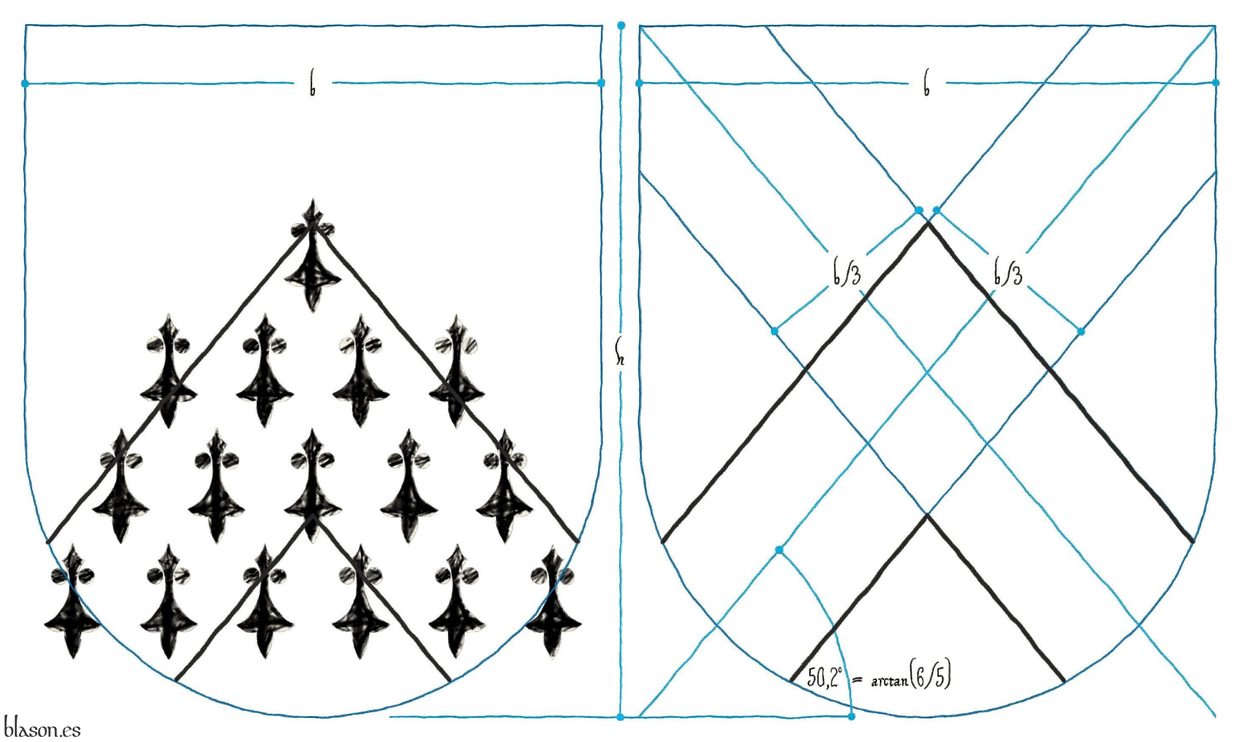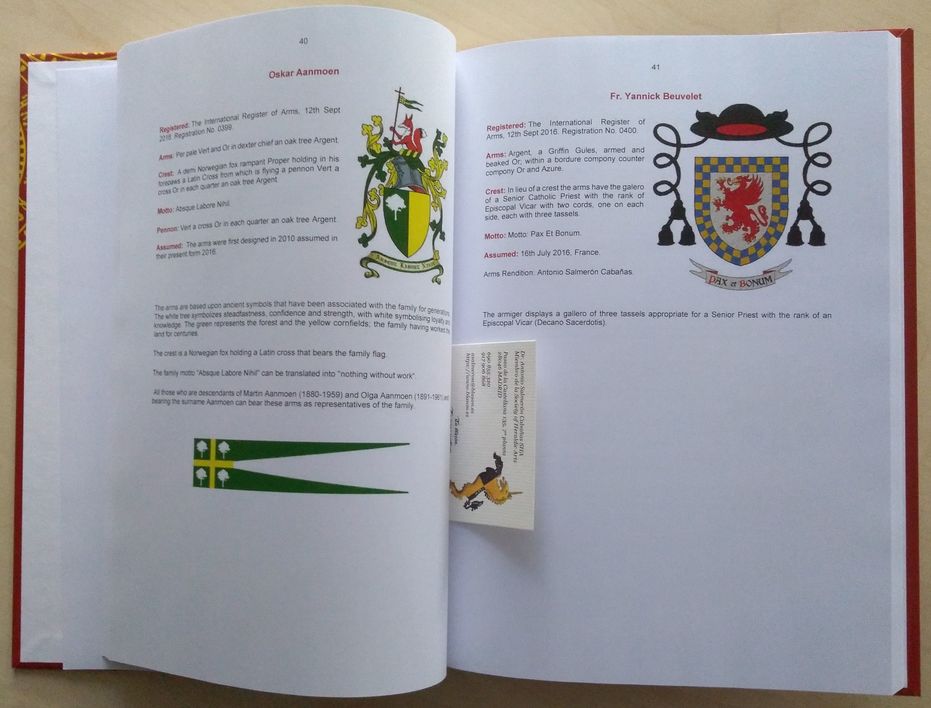
Baudry in France
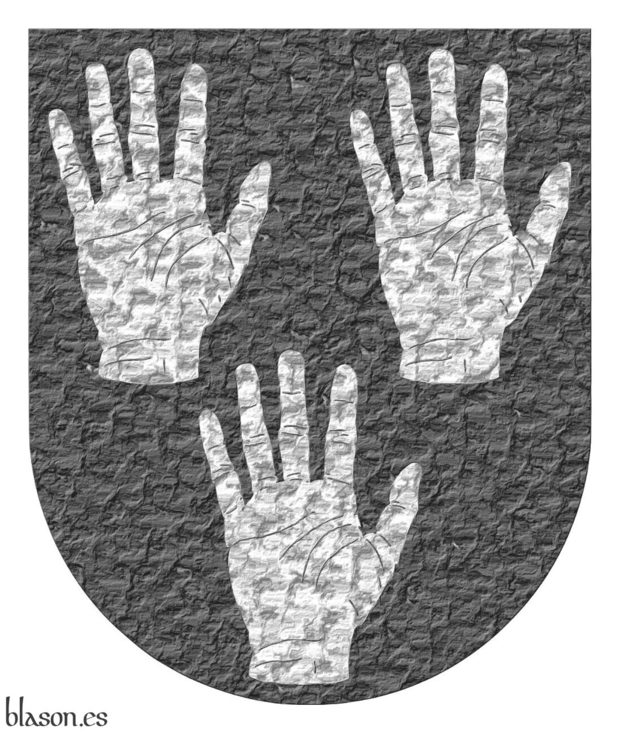
Sable, three dexter hands turned up, and appaumée Argent.
Escudo de sable, tres manos diestras levantadas y apalpadas de plata.
Coat of arms interpreted based on blazon and explanations of [Avilés, J.; 1725a; pages 34 y 35 y sheet 2 figure 38].
Blazon keywords: Without divisions, Sable, Three, Hand, Dexter, Argent, Turned up, Appaumée and Ordered.
Style keywords: Semi-circular, Plain tincture, Outlined in the field tincture and Soft metal.
Classification: Interpreted, Personal and Kingdom of France.
Bearer: Baudry en Francia.


John le Sturmy

Juan le Sturmy ~ Joan le Strumi ~ John le Sturmy.
Gules, a chevron Argent, between three Mullets Argent.
Escudo de gules, un cabrio de plata, acompañado de tres estrellas de cinco puntas de plata.
Included in [Vincent, MS; 1285; number 664] also known as [St. George's Roll; 1285; number 664].
Blazon keywords: Without divisions, Gules, One, Chevron, Argent, Between, Three and Mullet.
Style keywords: Pointed, Plain tincture and Outlined in sable.
Classification: Interpreted and Personal.
Bearer: Juan le Sturmy.
Blazon equivalent to: Howel Ap Rhys.


Basic chevron
Delineation, ratios and angles of a basic chevron.
Frente a los que denomino cabrio clásico y cabrio abierto, este se traza por el simple cruce de una banda y una barra.
Produce un desigual reparto de los espacios vacíos del campo, amplio por encima, escaso por debajo. Dependiendo del diseño que se haya que realizar, esto puede ser una ventaja o un inconveniente.
Por ejemplo, en este caso del escudo de Juan de Ladbrooke, no hay cargas ni figuras para las que habilitar espacio, sólo es un cabrio de armiños, por lo que esta forma de diseño puede ser adecuada y, más aún, si se desea un clara y patente representación del azur.
Sobre cómo se calculan los 50,2o del ángulo de este cabrio, empleando el arcotangente de 6/5, puede consultarse el artículo que lleva por título esquema de una banda y una barra.
Blazon keywords: Without divisions, Chevron and Ermine.
Style keywords: Semi-circular.
Classification: Schema.
Bearer: Juan de Ladbrooke.


John de Ladbrooke
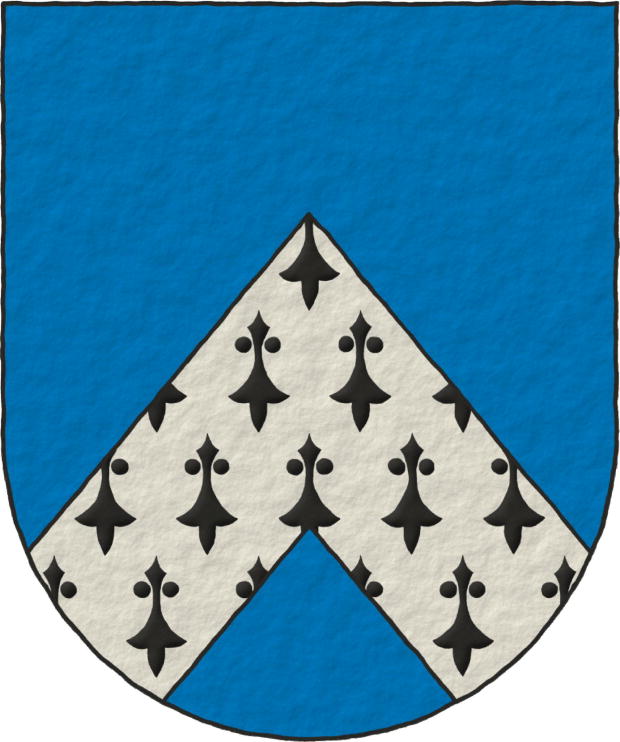
John de Ladbrooke ~ Joan de Lodbroke.
Azure, a chevron Ermine.
Escudo de azur, un cabrio de armiños.
Included in [Vincent, MS; 1285; number 662] also known as [St. George's Roll; 1285; number 662].
Blazon keywords: Without divisions, Azure, One, Chevron and Ermine.
Style keywords: Semi-circular, Illuminated and Outlined in sable.
Classification: Interpreted and Personal.
Bearer: Juan de Ladbrooke.


Yannick Beuvelet, The Armorial Register
Registered by The International Register of Arms, 12th of September of 2016, Registration number 0400, Volume 3.
[Armorial Register, T.; 2020; page 41].
Categories: Armorial roll, Griffin, Armed, Beaked, Bordure and Galero.
External link:
Root: The Armorial Register.


![Ver [The International Heraldry Society] en instituciones citadas. Fortaleza de oro y mazonada de sable.](../css/Fortaleza.Institucion.png)
The International Heraldry Society
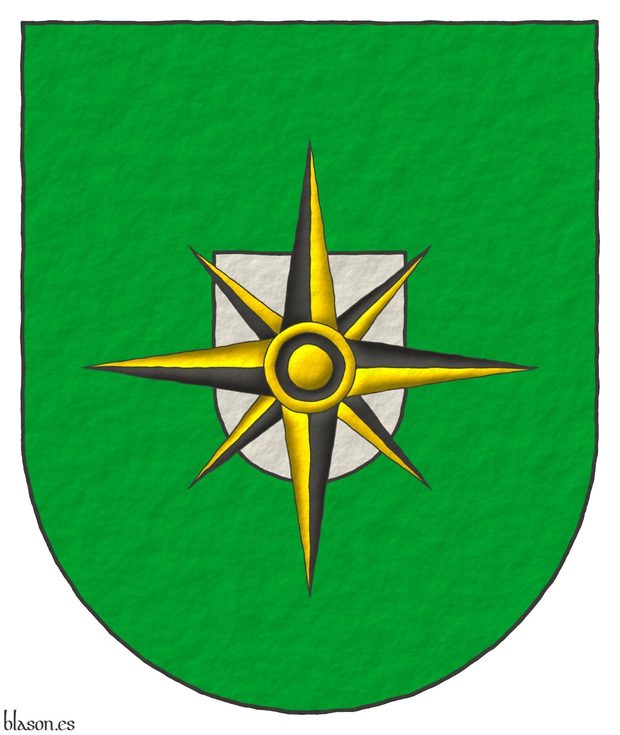
Vert, an inescutcheon Argent; overall a compass rose Sable and Or.
Escudo de sinople, un escusón de plata; brochante sobre el todo, una rosa de los vientos de sable y oro.
The International Heraldry Society has its Facebook group in the following address facebook.com/groups/int.herald.
Categories: Institution, Without divisions, Vert, Inescutcheon, Argent, Surmounted, Overall (deprecated), Compass rose, Sable and Or.


![Ver [The Heraldry Society of Scotland] en instituciones citadas. Fortaleza de oro y mazonada de sable.](../css/Fortaleza.Institucion.png)
The Heraldry Society of Scotland

Objectives and activities
The Heraldry Society of Scotland ~ «The Heraldry Society of Scotland», was founded in 1977. Its objectives are to promote the study of heraldry and to encourage its correct use both in Scotland and abroad.
The HSS (acronym for The Heraldry Society of Scotland) encourages those who have a coat of arms and those who intend to adopt their own arms to become members of the society and also encourages to join all those interested in Scottish heraldry, therefore the HSS admits and has members from all over the world.
The HSS holds active and regular meetings throughout the year and organizes conferences and visits to places of historical and heraldic interest, both within Scotland and in other countries.
Online content
They also maintain and update a website, whose domain is Heraldry-Scotland.co.uk, with interesting and abundant reading material, among which their list of online armorials with blazons in English stands out, among which the following armorials can be highlighted:
- Sir David Lindsay's Armorial from 1542, with 504 coats of arms and identification letters «DL», from «DL001» to «DL504». Includes imaginary coats of arms, for example, that of «DL011» of Hector of Troy which it imagines as «Sable, two lions combatant Or», which [Avilés, J.; 1725a; page 7] blazons with a Gules field, this difference would allow tracing the sources of each author, which would be interesting as it is, moreover, imaginary.
- Hamilton Armorial, from 1560, with 82 coats of arms they say, although only 79 appear, and identification letters «HM», from «HM001» to «HM079», where for example, «HM001» is the arms of Scotland «Or, a lion rampant Gules armed and langued Azure within a double tressure flory counter-flory Gules» and «HM026» is the insignia of Scotland «Or, a lion rampant within a double tressure flory counter-flory Gules».
- Queen Mary's Roll from 1562, with 204 coats of arms and identification letters «QM». from «QM001» to «QM204».
- Forman's Armorial from 1563, with 258 coats of arms they say, although only 247 appear, and identification letters «FAL», that is, from «FAL001», the arms of Scotland, to «FAL247».
- Slains Armorial from 1565, with 712 coats of arms they say, although only 638 appear, and identification letters «SL», that is, from «SL001» to «SL638».
- Armorial of Sir David Lindsay of the Mount, Secundus from 1599, with 285 coats of arms and identification letters «DLS».
- Seton Armorial from 1599, with 422 coats of arms and identification letters «SN», from «SN001» to «SN422».
- Dunvegan Armorial estimated to be around 1600, with 282 coats of arms they say, although only 52 appear, and identification letters «DV», only 2 digits and without leading zeros, from «DV1» to «DV52».
- Kings and Nobilities Arms, 2nd volume from 1638, with 111 coats of arms and identification letters «KNB», from «KNB001», the arms of the King of Scotland, to «KNB111».
- Nisbet's A System of Heraldry published in 1722, with 2,608 coats of arms, according to my count, and which I reference as [Nisbet, A.; 1722], 1st edition and [Nisbet, A.; 1816], for a later one that I have available. On the same page appears the blazon of Alexander Nisbet himself, in entry 1,926 according to my calculations, as «Argent, three boars' heads erased Sable within a bordure invected Gules», that is, «Argent: three boars' heads erased Sable; a bordure invected Gules» where «invected» ~ «acanalado» as opposed to «engrailed» ~ «angrelado».
I also find very interesting, for example, their pages on the basic principles of heraldic design, written by Doctor Patrick Barden.
Categories: Institution, Interpreted, Socioeconomic, Illuminated, Outlined in sable, Iridescent (nacar), Freehand, Semi-circular, Coat of arms, Without divisions, Azure, Saltire, Argent, Thistle, Couped (tree), In chief, In base, Inescutcheon and Gules.


The American College of Heraldry, blazon
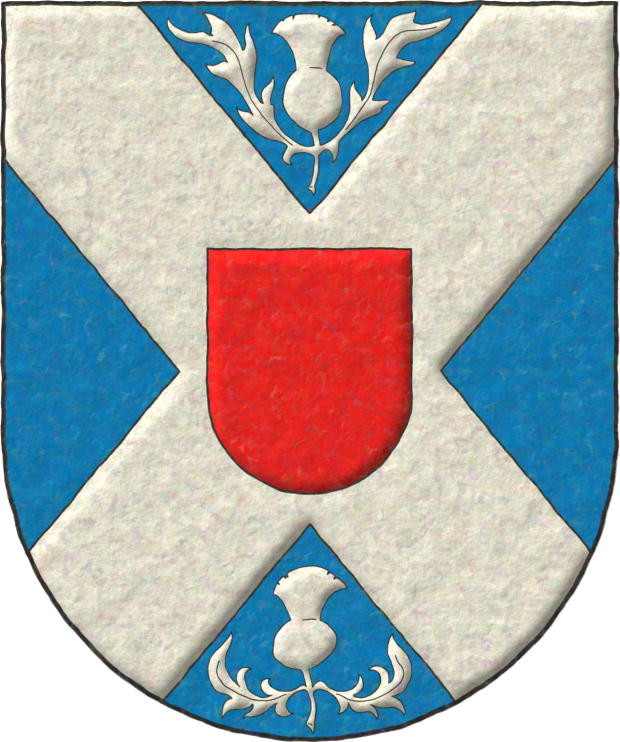
Azure, a saltire between, in chief and in base, two thistle couped Argent; an inescutcheon Gules.
Escudo de azur, un sotuer acompanado, en jefe y en punta, de dos cardos de nuridos todo de plata; un escusón de gules.
Coat of arms interpreted with the following characteristics: the shape of its shield is semicircular; the field is a flat tint of Azure; the two thistles and the saltire are illuminated of the metal Argent and outlined in Sable; the inescutcheon is illuminated of the colour Gules and, also, outlined in Sable; and the whole with a mother-of-pearl finish with a raised stroke.
Inescutcheon ~ escusón
The English term «inescutcheon» corresponds to our Spanish term «escusón». It is called an inescutcheon when there is only one and it is placed in the abyss of the shield.
Escutcheon ~ escudete
The English term «escutcheon» corresponds to our Spanish term «escudete». It is used when there are several, for example, 3. Although in this case there is only one, this is the term used in the official blazon of this coat of arms, as will be seen below.
Thistle ~ cardo
This coat of arms of The Heraldry Society of Scotland was registered and granted ~ «granted» on 7th September 1977, by «The Court of the Lord Lyon», which is the official college of arms for Scotland, lyon-court.com, with the following blazon: «Azure, on a saltire argent between two thistles slipped argent, one in chief and one in base, an escutcheon gules» and it contains 2 thistles, which is the national flower of Scotland, and a saltire Argent on an Azure field, like the flag of Scotland.
Slipped ~ nurido
The usual way of representing the thistle ~ «thistle» in Castile is with its roots visible, it is called «arrancado». In this case the stem is cut and its roots are not visible, it is called «slipped» ~ «nurido».
Blazon keywords: Without divisions, Azure, Saltire, Argent, Thistle, Couped (tree), In chief, In base, Inescutcheon and Gules.
Style keywords: Illuminated, Outlined in sable, Iridescent (nacar), Freehand and Semi-circular.
Classification: Interpreted, Socioeconomic and Coat of arms.
Bearer: The Heraldry Society of Scotland.

Continue with: Richard I of England.
-
Language
-
Categories of heraldry
-
Divisions of the field
- Without divisions
- Party per pale
- Party per fess
- Party per bend
- Party per bend sinister
- Tierce
- Tierce sinister
- Tierced per pale
- Tierced per fess
- Tierced per bend
- Tierced pallwise inverted
- Quarterly
- Quarterly per saltire
- Gyronny
- Party per fess, the chief per pale
- Party per pale, the sinister per fess
- Party per fess, the base per pale
- Party per pale, the dexter per fess
- Chapé
- Chaussé
- Embrassé
- Contre-embrassé
- Party per chevron
- Enté
- Enté en point
- Flanched
-
Metals
-
Colours
-
Furs
-
Other tinctures
-
Ordinaries and sub-ordinaries
-
Diminutives of the ordinaries
-
Other charges
-
Charges from Nature
Water, Eagle, Bald eagle, Eagle claw, Dorsal fin, Tail fin, Two hands clasped, Lark, Tree, Trunk, Rainbow, Atom, Barbel, Acorn, Bighorn sheep, Arm, Owl, Vulture, Horse, Head, Goat, Camellia, Thistle, Merino ram, Kapok tree, Stag, Doe, Crescent, Increscent, Chrysanthemum, Tail, Tail addorsed, Ermine spot, Hummingbird, Snowflake, Heart, Roe deer, Neck, Stags' attires, Roe deers' attires, Raven, Dolphin, Diamond, Tooth, Elephant, Trunk (elephant), Beetle, Emerald, Starling, Mullet, Mullet of four points, Star of David, Estoile, Male figure, Fleur de lis, Flower, Cornflower, Dogwood flower, Lotus flower, Hop cone, Bluebonnet, Puffin, Ash, Rooster, Claw, Talon, Goose, Heron, Seagull, Pomegranate, Sunflower, Swallow-tail, Falcon, Leaf, Boar, Goldfinch, Laurel, Barn owl, Lion, Lioness, Lion passant, Leopard, Lion rampant guardant, Lynx, Lily, Madonna lily, Flame, Wolf, She-wolf, Parrot, Moon, Hand, Apple, Apple tree, Sea, Martlet, Wing, Two wings in vol, Covert, Blackbird, Mount, Trimount, Fly, Wrist, Elm, Olive tree, Orbital, Bear, Palm frond, Palm tree, Dove, Poplar leaf, Panther, Jaguar, Vine, Paw, Forepaw, Foot (palmiped), Foreleg, Peacock, Chest, Pelican, Pelican in her piety, Dog, Brach hound, Warren hound, Fish, Hoof, Beak, Feather, Ostrich feather, Cinquefoil, Quetzal, Branch, Sprig, Frog, Shamrock, Caboshed, Oak, Holm oak, Rose, Double rose, Savage, Serpent, Plough of Ursa Major, Sun, Sun in splendour, Ray of the sun, Lightning flash, River, Stem, Badger, Tyger, Linden, Wheat, Wheat spike, Bull, Tulip, Udder, Escallop and Fox.
-
Artificial charges
Halberd, Plough share, Ace of spades, Anchor, Cyclamor, Torch, Bow, Arch, Harp, Non-classic artifact, Winnowing fan, Crozier, Conductor's baton, Pair of scales, Ship, Oar, Sail, Norman ship, Beret, Grenade, Ecclesiastical cap, Arm vambraced, Knight, Chain, Cup, Covered cup, Monstrance, Bell, Bell tower, Cannon, Cannon dismounted, Cannon port, Carbuncle, Castle, Ribbon, Clarion, Nail, Crucible, Cord, Dagger, Key ward, Turret, With a turret, Armillary sphere, Sword, Federschwert, Sabre, Parchment, Scroll, Skirt, Arrow, Club, Garb, Sheaf of tobacco, Scythe, Gauntlet, Axe, Buckle, Galician granary, Host, Bonfire, Polish winged hussar, Church, Fanon, Oil lamp, Spear, Spear's head, Fleam, Letter, Book, Open book, Closed book, Bookmark, Page, Line, Lantern, Key, Four crescents joined millsailwise, Hammer, Two-handed sword, Menorah, Mortar, Pestle, Number, Knot, Celtic Trinity knot, Water-bouget, Comb, Piano, Millstone, Millrind, Millwheel, Quill, Clay pot, Potent, Bridge, Cuffed, Hourglass, Chess rooks, Compass rose, Rosette of acanthus leaves, Mullet of six points pierced, Broken, Portcullis, Wheel, Wagon-wheel, Symbol, Sackbut, Drum, Geometric solid, Tetrahedron, Tower, Trident, Trumpet, Double vajra and Anvil.
-
Immaterial charges
Angel, Archangel, Basilisk, Heart enflamed, Sacred Heart of Jesus, Paschal lamb, Dragon's head, Dragon, Wyvern, Phoenix, Garuda, Griffin, Sea-griffin, Winged hand, Our Lady of Mercy, Pegasus, Saint George, Mermaid, Trinity, Triton, Golden fleece, Unicorn and Ouroboros.
-
External elements
-
Heraldic creations
-
References
-
Formats
-
Keywords on this page
Between, Combatant, Iridescent (nacar), Appaumée, Pointed, Armed, Ermine, Armorial roll, Azure, Baudry en Francia, Bordure, Surmounted, Chevron, Thistle, House of Plantagenet, Outlined in sable, Outlined in the field tincture, Dexter, In chief, In base, Coat of arms, Inescutcheon, Schema, Mullet, Galero, Personal, Griffin, Gules, Illuminated, Institution, Interpreted, Juan de Ladbrooke, Juan le Sturmy, Langued, Turned up, Lion, Semi-circular, Couped (tree), Or, Argent, Without divisions, Sable, Socioeconomic, Saltire, The Heraldry Society of Scotland, Plain tincture, Freehand, Three and One.
